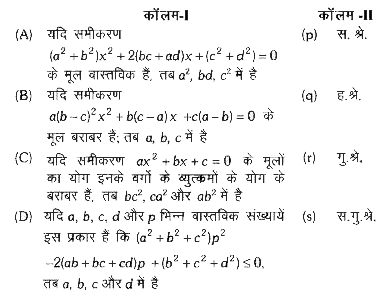समीकरण xlogx(1−x)2=9 का हल समुच्चय है
The solution set of equation xlogx(1−x)2=9 is :
{−2,4}
{4}
{0,−2,4}
इनमें से कोई नहीं
The correct Answer is:B
Step by step video, text & image solution for समीकरण x^(log_(x)(1-x)^(2))=9 का हल समुच्चय है The solution set of equation x^(log_(x)(1-x)^(2))=9 is : by Maths experts to help you in doubts & scoring excellent marks in Class 12 exams.
Updated on:21/07/2023Topper's Solved these Questions
- वर्ग समीकरण एवं असमिकायें BOOK - ERRORLESS HINDICHAPTER - वर्ग समीकरण एवं असमिकायें EXERCISE - Solved Multiple Choice Questions (मूलों तथा गुणांकों के मध्य सम्बन्ध)
58 Videos
- वर्ग समीकरण एवं असमिकायें BOOK - ERRORLESS HINDICHAPTER - वर्ग समीकरण एवं असमिकायें EXERCISE - Solved Multiple Choice Questions (मूलों के उभयनिष्ठ होने का प्रतिबंध, वर्ग व्यंजक व मूलों की स्थिति)
18 Videos
- वर्ग समीकरण एवं असमिकायें BOOK - ERRORLESS HINDICHAPTER - वर्ग समीकरण एवं असमिकायें EXERCISE - JEE Advanced (Matrix Match type questions)
2 Videos
- लघुगणक और आंशिक भिन्नें BOOK - ERRORLESS HINDICHAPTER - लघुगणक और आंशिक भिन्नें EXERCISE - JEE Advanced (integer type questions)
8 Videos
- वृत्त तथा वृत्तों का निकाय BOOK - ERRORLESS HINDICHAPTER - वृत्त तथा वृत्तों का निकाय EXERCISE - JEE Advanced (Integer type questions)
20 Videos
Similar Questions
यदि α तथा β समीकरण 4x2+3x+7=0 के मूल हों, तो 1α+1β=
If α and β are roots of 4x2+3x+7=0 then value of 1α+1β= is
View Solutionयदि दो समीकरणों x2−cx+d=0 तथा x2−ax+b=0 का एक उभयनिष्ठ मूल हो तथा दूसरा समीकरण समान मूल रखता है, तब 2(b+d)=
View Solution
View Solutionपद 6+log32⎛⎜ ⎜⎝13√2 ⎷4−13√2 ⎷4−13√2√4−13√2…⎞⎟ ⎟⎠ का मान है
View Solutionरेखा 2x−3y=1 वृत्तीय क्षेत्र x2+y2≤6 को दो भागों में विभाजित करती है। यदि
S={(2,34),(52,34),(14,−14),(18,14)}, तो S में स्थित उन बिन्दुओं की संख्या जो लघुत्तर भाग में अन्दर है, निम्न है
View Solutionlog_(3)(log_(9)x+(1)/(2)+9^(x))=2x
View Solutionlog_(3)(log_(9)x+(1)/(2)+9^(x))=2x
View SolutionThe solution set of the equation x^(log_(x)(1-x)^(2))=9 is
View SolutionSolve the following equation for x: 9^(log_(3)(log_(2)x))=log_(2)x-(log_(2)x)^(2)+1
View SolutionThe number of solutions set of the equation 4^(log_(9)x)-6.x^(log_(9)2)+2^(log_(3)27)=0 is
View SolutionIf log_((1)/(2))((x^(2)+6x+9)/(2(x+1)))<-log_(2)(x+1) then complete set of values of x is
View SolutionFind the number of solution(s) of the equation log_(9)(x+1)*log_(2)(x+1)-log_(9)(x+1)-log_(2)(x+1)+1=0
View SolutionThe number of real solution(s) of the equation 9log3(logex)=logex−(logex)2+1 is equal to
View SolutionThe number of integral solutions of log9(x+1).log2(x+1)−log9(x+1)−log2(x+1)+1<0 is
View Solutionlog3(log9x+12+9x)=2x
View Solution
